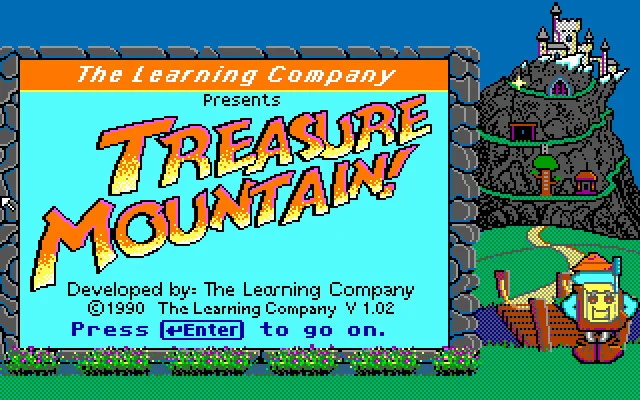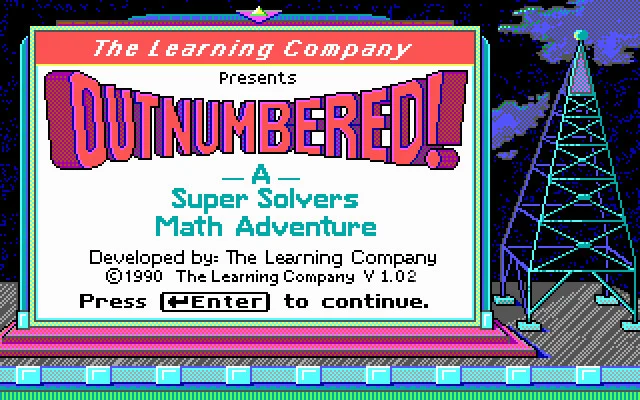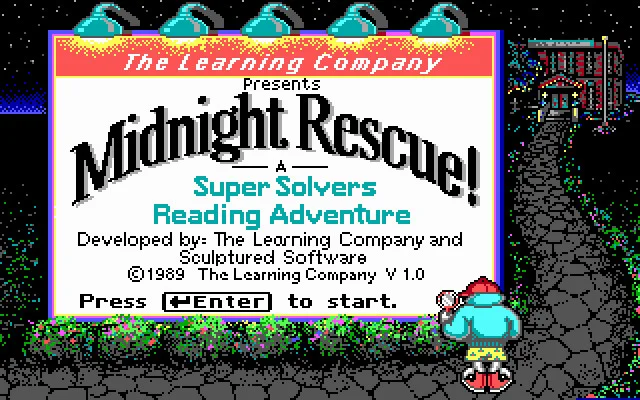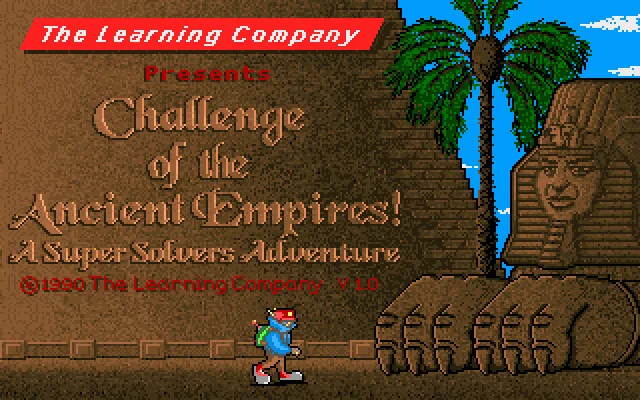I wanted to talk about these games, but it took a lot of work. What you’re reading here is part 1 of a script for a video about these games, planned for release later this month. Basically, enjoy this excerpt that just happens to be the first half of a longer video article.
Once upon a time, videogames were distributed on little flat rewriteable platters, and you weren’t likely to have a computer in your house. What did likely have a computer was your school, which probably had one and a bunch of stuff on it, with those platters. If it was anything like my school, it had things on it like word processing software and spreadsheet software and ugly desktop publishing software that didn’t use a mouse and then, of course, the true gem:
It probably had videogames.
And those videogames were probably ones that required no copy protection, because even schools pirated software.
In the period of the early 90s, the preserved-in-amber school PC often had some reliable mainstays of ‘educational’ games, and amongst those, the good ones, the real good ones, were the Super Solvers Games, by The Learning Company.
Chances are if you recognise that name, you know some of the games it includes; odds are unless you’re a super-dork like me, and maybe looked it up, you don’t know all the Super Solvers games, and may even find yourself wondering: Hey, were they any good? What even was in the Super Solvers franchise? What about that one? Why did it feel weird compared to the others?
It’s a little bit of a challenge to properly nail this down. The most comprehensive list are Treasure Mountain, Midnight Rescue, Outnumbered, Challenge of the Ancient Empires, Spellbound, Gizmos and Gadgets, Mission THINK and Operation Neptune. On the other hand, you could shorten the list to Midnight Rescue through to Mission Think, excluding Treasure Mountain and Operation Neptune. Of course, if you’re including Treasure Mountain, there are four more Treasure games, Treasure Mountain, Treasure MathStorm, Treasure Cove, and Treasure Galaxy, so why are they excluded? And what about Time Riders in American History, which sure feels like a Super Solver game, though it also feels a bit like a Carmen Sandiego game?
We’ll talk more about it later, but the actual Super Solvers branding jumping around like this is a byproduct of a period of PC Gaming where games were re-released a surprising amount. During the floppy disk era, it was extremely cheap to rerelease a game. The floppy disk was basically a fungible storage system, which meant that if a game failed to sell, you recalled its boxes and manual, then use the disks to sell another game. Or you could even rewrite or recompile the game to make changes, and then use the same disks to send it out again. It meant that the cost of a new version of a game could be very low, compared to console games of the time or even CD printed games. This meant for some companies in this space that had the pre-existing distribution networks, it was better to have a wide library of possible games, even more than you could necessarily easily distribute. Release a game, release it again, and every time, some of them sold. That’s why Treasure Mountain started as a Super Solver game, and Operation Neptune didn’t, and in later rereleases they were changed.
For me, the Super Solvers games start at Treasure Mountain and conclude at Gizmos and Gadgets, the last one I played. I wasn’t there, when the games were new. When I was paying attention, the games were already well-proliferated, pirated and shared. For me, then the games were presented more or less at the same time, and I explored them at my own pace, which as it happened, coincided with me finding them interesting and challenging.
Follow then, my journey that starts with…
I played Mission: THINK a little bit, but I remember at the time being unimpressed with how much like Gizmos and Gadgets it played. I would have collected footage of it and refreshed myself on how it plays, except Mission: THINK was a CD-Rom game and just a little bit more difficult to play than the other games.
Treasure Mountain
Americans are always talking about Oregon Trail as the great enduring challenge of the school computers.
Those Americans were missing out.
Oh sure you could call one of your settlers ‘p00p’ and hilariously die of dysentery in a game that wasn’t very challenging but mostly taught a student to pay attention to a small number of competing needs. It also looked like ass. Which is not unreasonable considering its age, since it came out in 1985.
The real treasure of the school computer for people who were still building basic literacy skills was Treasure Mountain, the 1990 game that introduced players to the Ageless Faceless Gender Neutral Culturally Ambiguous Adventure Person, and the ongoing villain of the story: Morty Maxwell, the Master of Mischief.
In Treasure Mountain, there’s this mountain, and it has treasures. But one day, Morty Maxwell steals all the treasures and then hides them around the place, which is a weird way to handle your thieving. You, a Super Solver (Seeker in later revisions of the Treasure games), are tasked to recover the treasures and topple Morty Maxwell.
You do this by climbing the mountain, which you do in the most unnecessarily ornate method; see, to get up the mountain you need to unlock a set of gates that take you further up. Each gate has a key, and each key is hidden on levels of the mountain. To find the key, you have to find the clues that lead to the key, which is hidden behind a single entity identified by three unique words – two adjectives and a noun, usually. Like, two red flags, or three square bushes, that kind of thing. When you find one, you throw a gold coin down on it, and hey, there if you found it, you’re in the right spot and can go.
To get the clues, you need to catch elves in a net – yes there are elves, but they’re the little short gnomey ones, not the tall elegant Mr Anderson types – and answer their questions. If you answer the question right, you get a clue, if the elf doesn’t have a clue they just give you some gold and woosh off, which makes the whole net arrangement feel a touch like a shakedown.
It’s not a complicated or challenging game, per se; as you move around the mountain you don’t get battered by various hazards or lose access to things — and there are even mechanics to help you catch up if you accidentally lose all your resources. Nets can be turned into coins, coins can be turned into nets, and the exchange rate between them is pretty forgiving.
Once you have the keys, and any number of the treasures, you break in to the castle, climb a ladder, dethrone Morty Maxwell (temporarily), stick your treasures into storage, then jump down a slide to start it all over again.
This game is a Game For Babies. It is not a challenging game, on its own, as it is. Everything about it is extremely basic, infinitely iterative, and the result of any given trip up the mountain is a number of treasures on a path to the end of the game, then back down again to the start. You can regard the game as ‘finished’ when you do one loop up the mountain, or you treat the end of the game as when you attain the highest rank and therefore have to do the play loop at least thirty times.
Thing is… you can make it challenging.
You can make it challenging if what you care about is finishing it quickly.
If you care about being able to get the treasures and keys as quickly as possible, making educated guesses, trying to make it up to the top with as few clues as possible, and while minimising your unnecessary loops around the mountain’s circular levels, this game for children presents you with a game where the only measure of success becomes a race against yourself and anyone else doing the same thing.
It’s a speedrunner’s game.
I didn’t play most of the Treasure games aside from Mountain for this. Officially, these games are Super Seeker games, you know, not the cool, aloof Solver games, this one was made for babies. The Treasure games are much simpler, but also they’re a lot more similar than the other games in the franchise. If you’ve played Treasure Mountain, you’ve played most of the Seekers.
Midnight Rescue & Outnumbered
Okay, I promise there’s a reason to lump these two games together, and it’s more than just that the two games follow very similar templates and were released at around the same time. In each case, these games are about your character being trapped in a closed environment, with a timer, with a limited resource for defending yourself, as you are hunted by something that you have to face to escape.
It’s an educational game, but the tension to it is … unexpected.
These games follow most of the same systems as Treasure Mountain under the hood. In Outnumbered, you’re moving around a local TV station that is under lockdown thanks to a pair of robots. One of them can’t be reasoned with and the other appears out of nowhere and chases you until you can do its math problems. Thing is, you need to do some of those math problems to get the clues necessary to work out where the villain is hiding.
In Midnight Rescue you’re in the local elementary school that is under lockdown thanks to a number of robots. They will appear at random points around you, chasing you down the halls or trying to impede you from getting clues, and if they hit you, they will burn the remaining time you have. Thing is, you need to photograph these robots or you won’t be able to deduce where the villain is hiding.
These two games are so very simple, and operate on the same principles, which is why it’s kind of remarkable that whenever I brought them up around any Fellow Gamers while we rubbed each other’s feet, they were all united in their same reaction to these two games:
These two games were so fucking scary.
Yes! I don’t know why, maybe it’s a byproduct of the clunky, grindy audio, the way the game makes it very clear you have no alternative but to confront these robots, the surprisingly short reaction times, or whatever, but somehow, what stood out to the audience at large is that Outnumbered and Midnight Rescue are games that, as far as genre markers go, are horrifying.
You might scoff at it now, and well, that’s reasonable because you’re at least fourteen years old or you wouldn’t be here — right? — but much in the same way that millenial culture has all these odd touchstones of remembering TV shows with surprisingly dark twists, it seems that if you were in the cohort that got to remember these games at all, you remembered them not for how they taught you reading skills or inductive reasoning, but instead for how how freaking scary it was to be chased by an angry television that wants you to do math.
Challenge of the Ancient Empires
Now this is the good stuff.
Morty Maxwell is back at it again, having gone to a number of what I guess must be archaeological sites around the world, stolen a bunch of important relics, then scattered the results all over the same ancient world, which is a bad thing to do. Much worse than stealing a bunch of important relics and taking them to England, return the Elgin Marbles you sponging arseholes.
Anyway, you travel through four ancient territories, Greece and Rome, the ‘Middle East,’ India and China, and Egypt. Each of those locations has a themed set of puzzles that include some bits and pieces of the culture they’re from, like how the Greek and Rome puzzles show you Greek characters, and how China is defined by using conveyer belts to move you past their enormous pez-spitting insects.
You finish these four worlds, you get an extra long-form world that mixes all the mechanics together, and then at the end of that you have to ring a gong while a… probably Indian goddess of some variety tries to kill you. Morty Maxwell enters the ‘finds out’ stage of things here and he fucking dies. That’s right, boom, turned to stone, the stone cracks, dude is now a decorative zen garden.
Then you come back and do it all again on Expert mode.
The Challenge of the Ancient Empires is one of those Super Solvers games that doesn’t compare easily to another game. While most of the others have sorts of sibling games, modelled on similar engines and play patterns, Ancient Empires is a puzzle platformer game. That’s all it is, too — there’s no elaborate bending of the game to try and make Educational Content happen at all. It’s just the game is made up of three types of basic puzzles; platforming puzzles, where you move around and press buttons and work conveyer belts and button sequences, that kinda thing, then you need to do a jigsaw puzzle, and then you solve a little logic puzzle and it’s off to the next stage of the game.
The game is honestly really good, just solid all-around in ‘game’ factors. There are some things that don’t look or feel great – the jumping can be a bit squeezed, the inconsistent behaviour of the light helmet not stopping certain kinds of enemies is annoying, and there are times where you might be left not sure if you should be able to make a jump or if you should be using your forcefield to get past it. It’s also a game where you can fail and lose progress, and have to reset, which can be really frustrating for tiny and easily frustrated children, or larger, and easily frustrated adults!
There’s a narrative that Ancient Empires started its life as a normal puzzle game, and was branded into the Super Solvers after a certain point, which may explain why Morty Maxwell is basically absent and the game doesn’t work the way that any of its predecessors do, and is instead just a garden-variety interesting puzzle game.
It holds up, even. Go check it out if you’re a Dosbox type. Hell, you can play it in-browser, and it’ll keep you entertained for a lunch break or two.
There’s a greater message here about how we regard the safety and provenance of important historical artifacts, and how in fact the safest place for historical items to be for future preservation is in the ground where nobody’s touching them. The vision of the explorer here does see the tombs and chambers of these ancient empires as being things that we want to enter and which are full of still living and still dangerous things that we are trying to navigate because the things they are protecting – and doing a very good job of protecting – are too important to leave where the people who owned them and cared about them put them.
I get it, I am kinda saying that archaeology is inherently bad, but let’s just say that there are better routes to doing it than the reason you can go to the British museum and see the Amvarati Collection from India.



